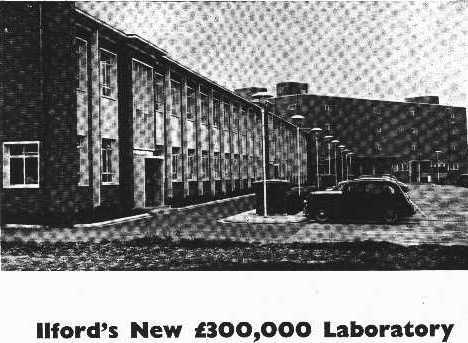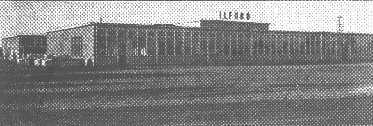 Photograph
courtesy of Ilford Anitec Australia.
Photograph
courtesy of Ilford Anitec Australia.
Ilford's new factory in England.
In England in 1879, an obscure 38 year old photographer named Alfred
Hugh Harman turned from his artistic trade to begin making and selling
dry gelatin photographic plates.
Harman made his plates in the basement of his house in a little English
village called Ilford, in the county of Essex, helped by his wife. He later
employed two men and three boys. Harman's determination and dedication
had much to do with his success but those attributes were commonplace in
that time. Obviously he had something else that was better than the rest
and that something was probably the recipe for his emulsion, which he kept
a great secret. He made his plates by pouring the emulsion from a teapot
onto a glass plate which was held on fingertips and tilted until it was
covered.
His company, originally called the Britannia Works, grew rapidly and
within four years he built a specially designed factory. By 1891 the Britannia
Works Company occupied a large site in the center of Ilford, employed about
50 people and claimed to be the largest manufacturer of photographic plates
in the world. The company was converted from a private to a public one
in 1897 so that Harman could retire for health reasons and in 1900 the
name changed to Ilford Limited.
The 2nd world war curtailed all research in colour films in the U.K.
to allow research to be directed toward the war effort. During this time,
Ilford made significant discoveries, particularly in aerial reconnaissance
and X-ray films.
After the war Ilford poured a lot of effort into colour film and by
1948 had a film that rivaled its competitors. Ilford colour "D" was a transparency
(slide) film and, by offering an entirely new print making service, they
were able to make up much of the lost ground in the colour field.

Photograph courtesy of Ilford Anitec Australia.
Ilford's Melbourne Plant.
In 1951 the Australian company was set up in West Melbourne with a
staff of about 10. In 1955 the company moved to its current Mount Waverly
site.
A new company, Ilford Inc., was formed in the U.S.A. and ICI, who were
interested in using its colour dyes in colour photography, made an offer
for 35% of the issued share capital in Ilford. With ICI's support, a new
colour negative film, "Ilfocolour", was introduced in 1960 which was very
successful. A new colour slide film, "Ilfochrome", was launched in 1962.
In 1963 Ilford agreed to an exchange of research ideas with CIBA AG
of Switzerland. CIBA were interested in using their dyes for a new silver
dye-bleaching process they were developing. Three years later "Cilchrome"
was introduced which was later named "Cibachrome".
In 1965 colour film was not selling as well as Ilford had hoped and
eventually Ilford discontinued selling Ilford branded colour film and paper
and eventually all colour film materials, except Cibachrome, were discontinued
in 1970.
In 1970 CIBA merged with J.R.Geigy. Ilford continued developing its
black and white and Cibachrome products.
In 1989 Ilford was acquired by the International Paper company of the
U.S.A. which also owned Anitec, a U.S. based manufacturer of graphic arts
materials, The two groups were merged to become Ilford Anitec in 1990.



Prev. Home Next
 Photograph
courtesy of Ilford Anitec Australia.
Photograph
courtesy of Ilford Anitec Australia.
